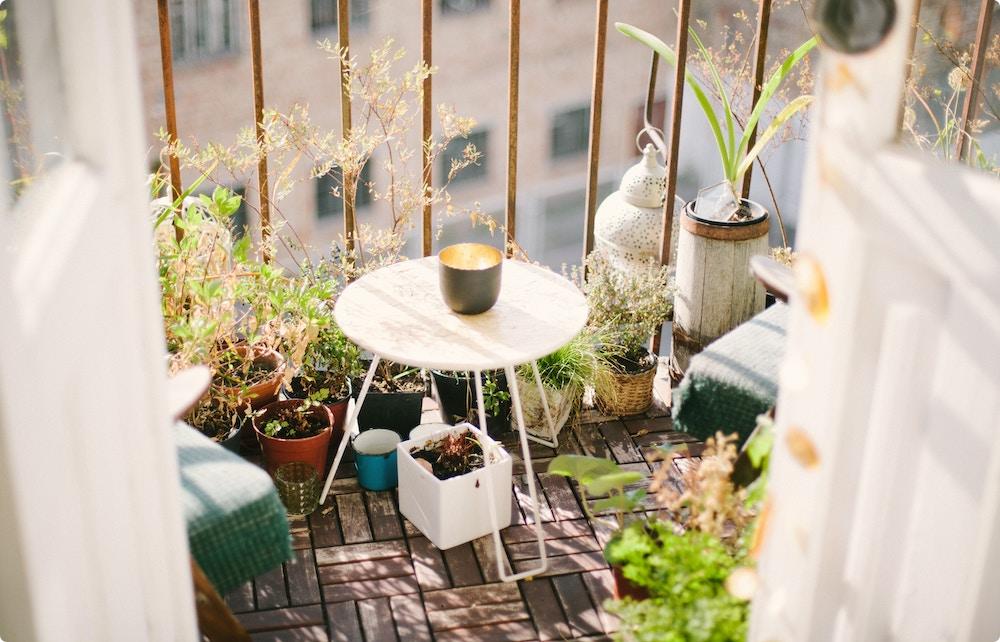At Resi, we aim to be the pioneers of wellbeing-focused home design. That’s why, in 2020, we commissioned The Science of a Happy Home report. This research identified six qualities that help create happiness at home by combining the best exisiting research and surveying over 4000 people nationwide.
If spending time in your home has got you feeling not at your best, feeling a little on edge, then consider this advice from our designers...
Give yourself some security
Everyone wants to feel secure within their homes, however, for some this just isn’t the case. Even more unfortunate, these worries are often out of our hands. Perhaps you have a nasty landlord or are faced with a repair bill you just can't afford to cover.
However, there are a few ways we can get some control over these issues.
For renters, you might consider…
- Negotiating for a longer tenancy period.
- Getting your deposit in a protection scheme.
- Looking into government initiatives that may help you get on the housing ladder (should that be your goal).
For homeowners facing their own worries, your options include…
- Investing early on in a good home insurance plan.
- Before moving in, asking the seller or your landlord for a copy of the building control certificate.
- Also, before buying any property, you should have a surveyor pop round to unearth any hidden defects.
Learn more about making your home more secure.
Have your home adapt to your needs
We can spend decades within the same house, so why shouldn’t it grow with us? Not only adapting to our needs as we go through different stages of our lives, but also on a more day to day level.
After all, they call it a living room, not a ‘sit down and watch TV room’. Our spaces should be able to accommodate all kinds of activities from yoga to crafting, dinner parties to cosy blanket forts.
If you want to make the most of your space, consider the easy adapting fixes…
Within your bigger, more habited rooms, consider investing in movable furniture. This allows the space to expand and shrink, depending on what you’re up to.
Good storage is a must. Whether this is as small as a few containers or even by going big with underfloor cubbies, adding recesses into the walls. Anything that will help you free up space from under the clutter.
If you have budget to spare, then you can think long-term about your needs. Consider these ideas when redesigning an area of your home…
Many homeowners are put off from adding a bedroom to their ground-floor, as they tend to offer less returns on resale. However, not only is a bedroom on this level easy to create, thanks to rear extensions or a garage conversion, they’re also highly adaptable. What could be used as a cinema room or office now could provide a stair-free bedroom in the future.
Those with younger children tend to prefer open-plan layouts, as it makes juggling the day to day household management and childcare that much simpler. As your kids get older and start to prefer their own space (you might too, with teens!), parents can adapt an open-plan to a more broken up style. A broken-plan layout, which helps break up big spaces, can be accomplished easily through new shelving or easy to install half-walls.
If open-plan isn’t right for your home, consider adding in a playroom. Research has shown that creating a distinction between sleeping areas and play areas helps promote a good night’s sleep in young children. This can then be adapted into an office in the future or a separate living space for teens to enjoy.
Learn more about making your home more adaptable.

Does your home mirror who you are?
If you tried to dress like someone else likely you would start to feel uncomfortable. Your home is no different. While trends can be great for inspiration, you want to make sure your home is still reflecting who you are - your unique tastes and personal quirks.
If you’ve yet to discover a style of decorating that feels right, consider these tips…
When it comes to decorating your home, remember it’s okay to take your time. While we might need to rush out to purchase the essentials, such as a bed, sofa, somewhere to store our clothes, the rest of our possessions should be allowed time to accumulate. Pick items personal to you, mementos of good times, or just simply things you truly love. Going slower will also mean you can save up for bigger, longer-lasting items.
If you do find yourself feeling the pull of the trends, consider what it is you like about them. Are there particular colours which pull you in? Are the spaces you like busy or calm? Perhaps you prefer maximalism over minimalism. Rather than defining the look of your home, trends should be helping you define your own unique taste, even as it changes over the years.
Learn more about making your home feel more like you.
Give yourself that ‘ahhh’ moment
Homes can be a great way to nurture hobbies and spend time with loved ones, but they should also be a place where we can switch off too. This is more important than ever if you find yourself working from home, as otherwise you’ll never be able to put aside those upcoming deadlines.
If you’ve yet to perfect a great chill-out area, here are some of our recommendations…
- Create wall nooks for work, reading and those quiet moments.
- If your bedroom is where you relax best, add in a space where you can mellow that’s not just the bed itself. Even small rooms have space for a reading chair.
- Plants, plants and more plants! Getting more natural features into your home will not only provide a pleasing visual but can also help with air quality.
- Warm, soft lighting will help promote a better night’s sleep, while those with blue undertones or bright white, will only keep you awake for longer. For those rooms with little daylight, purchase ‘biodynamic’ lights which will help with your natural body clock.
Learn more about making your home more relaxing.
Feel nourished by your surroundings
What does it mean to have a nourishing home? Have we perhaps confused homes with smoothies? Nope. Our Happy Home report has found everyone needs a home that provides conditions that allow us to be healthy and thrive - this is what it means for a home to nourish.
Easy wins to help promote health at home include…
Improving your air quality. Though plants can help towards this, for more robust results, you might consider getting an air filter installed or look into what materials currently make up your home - old insulation can sometimes be bad for our health.
Keeping your home at a comfortable temperature by making sure your insulation is up to scratch. If you’re looking for the gold standard, check out the Passivhaus standard.
Maximising on natural light. Either go big by installing skylights or add some interior touches the promote it, such as big mirrors to bounce light around the room, or white walls.
Opening up your floor plan. An open-plan layout can help light travel through your home, bring more space into your home as you eliminate corridors, and make it easier to connect to people in your household.
However, if you do opt for an open plan layout, make sure you consider how you’ll heat this much larger space. Underfloor heating is often a good shout.
Learn more about adding nourishment to your household.

Make sure you have room to connect
By nature, many of us are social and so our homes should reflect this by including spaces that allow us to make and fortify our connections to others.
How we connect with one another changes from household to household. For some people, socialising involves big dinner parties, while for others they like to meet up more casually, either through hanging out around the breakfast bar or getting curled up in the living room. Think about how your family meets up day to day and work with it, rather than design your home around how you think they should behave.
One of the easiest ways of bringing your household together is through an open-plan layout. As we’ve discussed previously, this floorplan has plenty of benefits but there are a few things to bear in mind…
You’ll need to work out how to live in an open-plan space day to day. Interior design can help define your living room from your kitchen diner, so it’s worthwhile visualising this with your architect beforehand, who can often offer up some ideas.
If you’d like to retain more privacy between the rooms, look into sliding doors, half-walls, and shelves to break up the space.
Also, you can build connections outside of people. Our research has shown that building a better relationship with your outside space is just as important for our wellbeing. Consider…
Having your windows make the most of any surrounding views. Bi-fold and sliding doors offer a fantastic chance to add large open views of our garden, as well as making it easier to spend time inside and out.
For those without a garden of their own, balconies might prove to be a good alternative. For those on a tighter budget, even Juliet balconies have their benefits, and you can even install them under your permitted development rights.
Learn more about building connections.
Not sure where to start on improving your home? Take our Happy Homes test to discover your wellness score. We’ll identify what your home is already doing well and which happiness qualities could do with an improvement. Alternatively, if you want advice straight from the expert’s mouth, book in a free consultation to discuss any potential projects with our team.






















